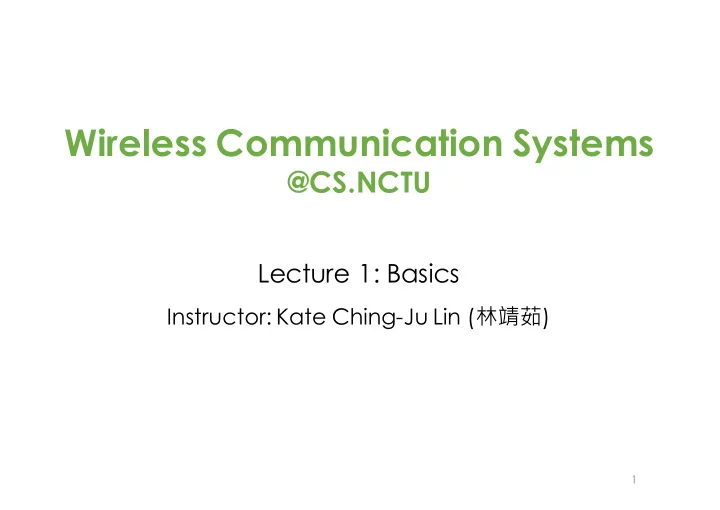

Wireless Communication Systems @CS.NCTU Lecture 1: Basics Instructor: Kate Ching-Ju Lin ( 林靖茹 ) 1
Wireless Signal e ix = cos x + j sin x • Sine wave noise phase change due to channel propagation delay y = hx + n h = α e − 2 j π f c ( t + θ ) received transmitted amplitude signal signal What is channel? Signal variation (amplitude and phase) over the air 2
Constellation Diagram • Signal can be described as a sine wave x ( t ) = A ( t ) cos( ω t + θ ( t )) = A ( t ) e j ( ω t + θ ( t )) + e − j ( ω t + θ ( t )) 2 = Re [ A ( t ) e − j ( ω t + θ ( t )) ] = Re [ A ( t ) e − j θ ( t ) e − j ω t ] = Re [˜ x ( t ) e − j ω t ] = Re [( I ( t ) + jQ ( t )) e − j ω t ] = I ( t ) cos( ω t ) + Q ( t ) sin( ω t ) • Rearranged as inphase and quadrature 3
Constellation Diagram Constellation diagram Q (I(t), Q(t)) Q(t) x ( t ) = A ( t ) cos( ω t + θ ( t )) = I ( t ) cos( ω t ) + Q ( t ) sin( ω t ) = I ( t ) + jQ ( t ) θ (t) I I(t) • Represent a wireless signal as a complex number • Sine carrier: image part • Cosine carrier: real part • Why complex value? • Sine and Cosine are orthogonal with each other • Two carriers on the same frequency à rate ⬆ 4
Signal Power • Watt vs. Decibel ( dBm ) • dBm is usually used in radio • Able to express both very large and very small values in a short form P dBm = 10 log 10 (1000 P W ) P W = 10 P dBm / 10 1000 • dB : difference between two dBm values • ratio of two power = difference between two dBm P1toP2 dB = 10 log 10 ( P 1 ) P 2 = 10 log 10 ( P 1 ) − 10 log 10 ( P 2 ) = P 1 ,dBm − P 2 ,dBm 5
SNR Q • Signal-to-Noise Ratio s’ = a+bi S n I N • Decoding SNR • In dB • Sent s=1+0i S but receive s’= a+bi 10 log 10 • Signal power N = s 2 =|1+0i| 2 • From equation • Noise power = |s-s’| 2 = |(a+bi) – (1+0i)| 2 y = hx + n = |(a-1)+bi| 2 | h | 2 | 1 + 0 i | 2 SNR = SNR = | ( a − 1) + bi | 2 E [ | n | 2 ] 6
Power vs. dB • Because of the log operation, double the power produces 3dB gain SNR dB = 10 log 10 SNR ⇒ P 1 ,dB = P 2 ,dB + 3 dB P 1 = 2 ∗ P 2 ⇐ 7
Path Loss • Attenuation reduction as the signal propagates through the air • Friis Transmission Formula � λ � 2 P r (in Watt) = D t D r P t 4 π d � λ � (in dB) P r − P t = D t + D r + 20 log 10 4 π d • λ : signal wavelength • Pt/Pr: transmitting/receiving power • Dt/Dr: directivity of transmitting/receiving antenna • Loss ∝ distance 2 8
Shannon Capacity • The tight upper bound on the data rate � � 1 + S C = B log 2 = B log 2 (1 + SNR ) N • B: bandwidth (Hz), e.g., WiFi with 20MHz • S and N is in Watt (SNR is power ratio, not in dB) • In low SNR regime, increasing SNR can increase the rate significantly • In high SNR regime, the increase in rate from SNR gain is relatively small 9
Equalization • Reversal of distortion incurred by a signal transmitted through a channel • Equalizer : recover the transmitted signal from the received signal • a.k.a. decoding • Solution: MMSE, Zero-forcing, etc. • Example y = hx + n ⇒ x 0 = y h = x + n h 10
Coherence Time • The time over which a propagating wave may be considered coherent (i.e., staying constant) • Why this is important? • To decode the signal, we need to estimate the channel h • The time interval between consecutive channel estimation should be shorter than coherence time • Otherwise, decoding can be erroneous due to incorrect channel h 11
Recommend
More recommend